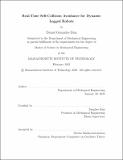Real-Time Self-Collision Avoidance for Dynamic Legged Robots
Author(s)
Gonzalez Diaz, Daniel
DownloadThesis PDF (8.662Mb)
Advisor
Kim, Sangbae
Terms of use
Metadata
Show full item recordAbstract
Avoiding self-collisions is particularly challenging for legged robots, yet critical for them to avoid falling and damaging themselves. Unlike standard obstacle avoidance where the obstacles in the environment are relatively static, in self-collision avoidance the "obstacles" are the robot’s limbs which are more dynamic. Enforcing self-collision avoidance as a constraint can conflict with other control objectives, such as stability or foot placement. Ensuring that these conflicts are resolved in real-time is critical for hardware deployment. This work presents a reactive collision avoidance framework that combines Control Barrier Functions with a Whole-Body Controller that can reason about the robot’s full dynamics to guarantee collision-free motions when tracking motions from a high-level dynamics planner. The effectiveness of this approach is validated in simulation with walking experiments showing that adding Control Barrier Functions avoids leg self-collisions when the high-level planner’s footstep location or swing trajectory is infeasible for the real robot. Additionally, the approach generates feasible arm motions that improve disturbance recovery in real-time. Finally, the framework is extended for hardware implementation on the MIT Humanoid with an additional controller that solves for joint velocities to avoid swing-leg collisions in hardware experiments.
Date issued
2023-02Department
Massachusetts Institute of Technology. Department of Mechanical EngineeringPublisher
Massachusetts Institute of Technology